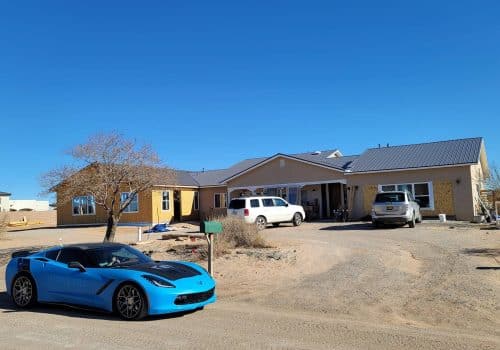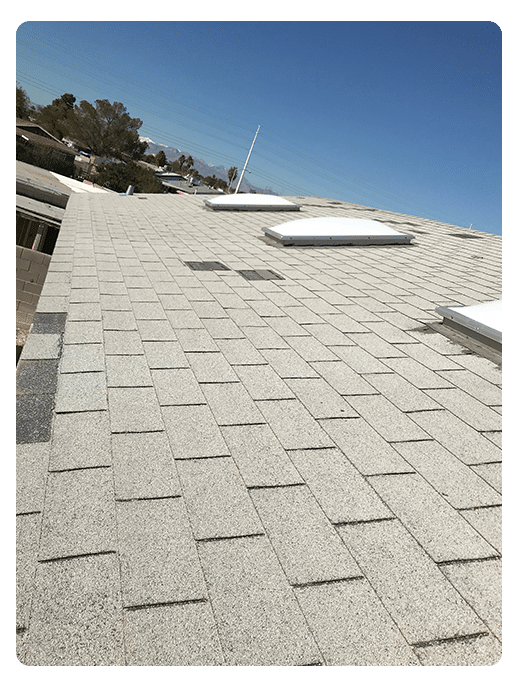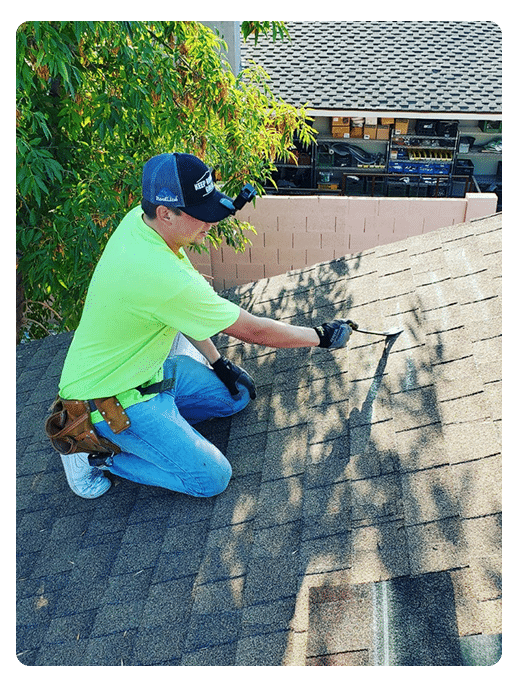Ice dams are a serious problem for residential roofs, as they can cause lasting damage and result in costly repairs. By understanding how ice dams form and what measures to take to prevent them, homeowners can save time and money while protecting the integrity of their roof.
This article provides an overview of how to spot and prevent ice dams on a residential roof. Ice dam formation occurs when snow melts from rising temperatures or direct sunlight and refreezes at the edge of the roof line due to colder temperatures. When this happens, water accumulates behind the frozen area and backs up under shingles, potentially leading to leaks inside walls or ceilings.
Homeowners should be aware that preventive steps taken ahead of time could provide long-term savings by avoiding unnecessary repair costs associated with ice dam removal.
What Are Ice Dams?
Ice dams are a common issue in colder climates with roofs that have snow and ice accumulating on them. They form when heat from the home escapes through the roof, melting some of the lower-level snow which then flows down to the edge of the roof where it refreezes due to cold temperatures.
This creates an obstruction along the eaves that can trap additional melted water behind it, leading to leaks or damage within the home’s interior walls and ceiling. Ice damming is also dangerous as it places extra weight on a roof, potentially causing structural damage.
The most effective way to prevent ice dams is by improving insulation throughout the house and ensuring adequate ventilation in attics so that warm air does not escape upwards into attics or onto upper levels of outside walls. Sealing off any areas around pipes, electrical outlets, chimneys, etc., will help keep warm air from entering these spaces and melting snow at higher elevations on your roof.

Additionally, having gutters cleared regularly during winter months prevents built up ice from forming at edges of roofs. Taking these simple steps can ensure your family stays safe while avoiding costly repairs resulting from ice dam formation.
Causes Of Ice Dams
Ice dams are a type of ice formation created when snow melts on the roof and refreezes. They can cause serious damage to roofs, gutters and walls if not addressed quickly. It is vital for homeowners to understand the causes of ice dams in order to take preventative measures before they occur.
Heat loss from an inadequately insulated attic or upper floor space is one major factor that contributes to this issue. Heat naturally rises through the home, but it becomes trapped in warm air pockets within the attic due to insufficient insulation. This heat then warms up the rooftop surface area enough to melt any accumulated snowfall which collects around eaves and valleys where temperatures may remain lower than other areas of the roof.
As this melted water runs down towards colder areas, it will freeze again into solid ice formations known as ice dams. Factors such as poor ventilation, low-slope roof design and heavy accumulations of snow can also contribute to their development over time.
Identification Of Ice Dams
Ice dams are a common occurrence in residential roofing systems, particularly during the winter months. As temperatures drop and snow accumulates on rooftops, ice begins to form along the edges of the roof and can cause serious damage if not addressed promptly.
Identification of an ice dam is relatively straightforward, but prevention requires more specific action. Signs that indicate an ice dam has formed include icicles hanging from eaves or gutters, water stains on interior walls and ceilings, clogged gutters due to frozen debris buildup, and evidence of shingle deterioration or buckling.
In order to prevent future occurrences of these damaging phenomena, homeowners should take steps such as increasing insulation levels within their attics, installing metal drip edge around the perimeter of the roofline and making sure that all vents are properly sealed against infiltration from outside air. Additionally, clearing snow off roofs after significant accumulation events can help reduce potential for further damage by allowing colder exterior temperatures to dissipate quicker into warmer inside spaces.
Understanding The Impact Of Ice Dams
Ice dams can cause extensive damage to a residential roof, including leaks and water infiltration. Understanding the impact of ice dams is essential for home owners who want to avoid costly repairs and build an effective plan for prevention.
Ice dams form when snow on the roof melts faster than it can drain away due to warm attic air rising up from below, resulting in pools of melting water that refreezes along the eaves of the roof line. This creates a dam that prevents further drainage and causes melted snow to back up underneath shingles and into attics or living spaces.
The presence of ice dams can also increase structural integrity issues such as sagging gutters or weakened supports. In extreme cases, heavy weight from large accumulations of ice can even lead to collapsed roofs.
In addition to physical damage, prolonged exposure to standing water caused by ice dams can result in mold growth on interior walls or ceilings, creating additional risks to health and safety as well as increasing repair costs.
To prevent these types of damages, home owners must take proactive steps such as proper insulation and ventilation so heat doesn’t rise through the attic and cause snow melt near the top edge of the roofline. Additionally, removing excess snow regularly before temperatures drop too low will help ensure any remaining moisture has time to safely drain off rather than freeze in place.
Preventive Measures For Ice Dams
In order to prevent ice dams from forming on a residential roof, there are several preventive measures that can be taken.
One of the most important aspects is to ensure proper insulation and venting in the attic space. Heat escaping from the home will cause snow melt which then runs down the roof and refreezes at colder areas near the eaves, creating an ice dam. Proper ventilation also helps keep temperatures even throughout the attic, reducing chances for warm air pockets where snow melts may occur.
It is critical that gutters and downspouts remain free of debris so melting snow can drain off properly. Improperly functioning gutters or clogged downspouts can lead to water pooling along the edge of roofs, increasing risk of icicles and ice buildup.
Additionally, it is beneficial to install heating cables along vulnerable sections of roof edges as these help melt off any existing or incoming accumulation of snow before it has time to freeze into an ice dam. Regular maintenance should include keeping all elements clear of leaves, twigs and other obstructions that could impede drainage or block vents.
Removal Of Existing Ice Dams
Removal of existing ice dams must be done with special caution and consideration. This process should never involve the use of sharp tools, such as knives or chisels, to chip away at the ice. Doing so can damage both the roofing material and underlying insulation.
The goal should instead be to slowly melt the accumulations using heat-based methods that are safe for residential rooftops. A variety of products is available on the market specifically designed for this purpose. These include heated cables, mats, and coils; all of which can be used in combination with a generator or another external power source to safely remove large amounts of snow and ice from a rooftop surface without damaging it.
However, these products should always be installed according to manufacturer guidelines for optimal safety and effectiveness. Additionally, proper ventilation must also be ensured prior to beginning any removal operation.

Expert Tips For Ice Dam Prevention
The removal of existing ice dams is a necessary first step in protecting a residential roof. However, it is just as important to take proactive steps to prevent ice dam formation before they occur. The following expert tips can help homeowners spot and prevent ice dams on their roofs:
-
First, inspect the attic for air leaks that allow warm air to escape into the space between the insulation and the roof decking. This warm air melts snow which then refreezes at the edge of the roof causing an ice dam. Sealing up any cracks or openings with weatherstripping, caulk, and gaskets will keep heat from escaping, thereby preventing icing conditions on your home’s roof.
-
Additionally, make sure that there are no areas where vents or pipes come through walls without proper sealing around them.
- In addition to inspecting for gaps or cracks that leak air out of attics, experts also suggest clearing away debris such as dead leaves or sticks so water does not become trapped near gutters and drainspouts.
-
If possible, adding metal edging along eaves helps direct melted snow off rooftops instead of allowing it to accumulate and freeze again at these lower points along edges.
-
Installing adequate attic ventilation systems during construction can also be beneficial in reducing heat build-up within homes while keeping moisture levels low enough so condensation won’t form on interior surfaces like ceilings and rafters—another common cause of icy conditions outside atop residences.
Conclusion
Ice dams pose a serious threat to residential roofs, and it is important for homeowners to understand how best to identify and prevent them.
By taking preventive measures such as increasing insulation, sealing air leaks, installing ice guards or heated cables on the roof, and keeping gutters clean of debris, one can reduce their chances of experiencing an ice dam.
Additionally, when removing existing ice dams it is essential that care be taken not to damage the shingles in the process.
Homeowners should take necessary steps to ensure they are properly protecting their home from potential damages caused by ice dams.


